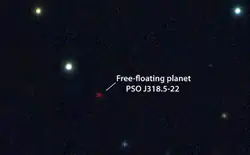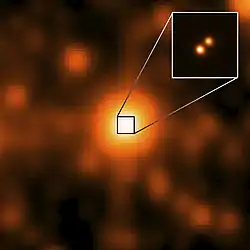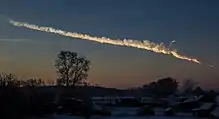PSO J318.5−22
PSO J318.5−22 is a rogue planet, an extrasolar object of planetary mass that does not orbit a parent star.[2][3] It is approximately 80 light-years away, and belongs to the Beta Pictoris moving group.[4] The object was discovered in 2013 in images taken by the Pan-STARRS PS1 wide-field telescope. PSO J318.5-22's age is inferred to be 12 million years, the same age as the Beta Pictoris group.[5] Based on its calculated temperature and age, it is classified under the brown dwarf spectral type L7.[1]
 PSO J318.5-22 (red object) imaged by the Pan-STARRS PS1 telescope in 2013 | |
| Discovery | |
|---|---|
| Discovery site | Pan-STARRS PS1 telescope, Haleakalā |
| Direct imaging | |
| Physical characteristics | |
Mean radius | 1.53 RJ |
| Mass | 6.5+1.3 −1 MJ[1] |
| Temperature | 1160+30 −40 K[1] |
Spectral type | L7 |

The team leader, Michael Liu of the Institute for Astronomy at the University of Hawaii, stated: "We have never before seen an object free-floating in space that looks like this. It has all the characteristics of young planets found around other stars, but it is drifting out there all alone."[6] Current theories about such objects include the possibility that gravitational perturbations may have kicked them out of their planetary systems soon after they formed through planetary accretion, or they may have been formed by some other means.[7] Estimated temperatures inside its clouds exceed 1,100 K (800 °C). The clouds, made of hot dust and molten iron, show how widespread clouds are in planets and planet-like objects.[8]
See also
References
- Michael C. Liu; Eugene A. Magnier; Niall R. Deacon; Katelyn N. Allers; et al. (1 October 2013). "The Extremely Red, Young L Dwarf PSO J318-22: A Free-Floating Planetary-Mass Analog to Directly Imaged Young Gas-Giant Planets". Astrophysical Journal Letters. 777. arXiv:1310.0457. Bibcode:2013ApJ...777L..20L. doi:10.1088/2041-8205/777/2/L20.
- "Gemini Confirms Lonely Planet Floating in Space". Gemini Observatory. 7 October 2013.
- "Astronomers using Hawaii telescopes discover planet without a star". Honolulu Star-Advertiser. 9 October 2013.
- "A Strange Lonely Planet Found Without a Star". ScienceDaily. 9 October 2013.
- "A Strange Lonely Planet Found without a Star". Institute for Astronomy, University of Hawaii. 9 October 2013.
- Young planet, six times more massive than Jupiter, found hanging alone without star Archived 14 October 2013 at the Wayback Machine Shelly Jones, Pentagon Post, 12 October 2013
- Alan Boyle (9 October 2013), Astronomers say they've spotted lonesome planet without a sun, NBC News
- "Edinburgh University astronomers find sunless world". 3 November 2015.



